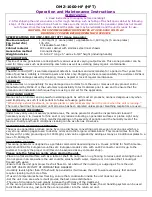
Cautions
Checks to electrical devices
- Repair and maintenance to electrical components shall include initial safety checks and component inspection
procedures. If a fault exists that could compromise safety, then no electrical supply shall be connected to the circuit until it
is satisfactorily dealt with. If the fault cannot be corrected immediately but it is necessary to continue operation, an
adequate temporary solution shall be used. This shall be reported to the owner of the equipment so all parties are
advised.
- Initial safety checks shall include:
• that capacitors are discharged: this shall be done in a safe manner to avoid possibility of sparking;
• that no live electrical components and wiring are exposed while charging, recovering or purging the system;
• that there is continuity of earth bonding.
Repairs to sealed components
- During repairs to sealed components, all electrical supplies shall be disconnected prior to any removal of sealed
covers, etc. If it is absolutely necessary to have an electrical supply to equipment during servicing, then a permanently
operating form of leak detection shall be located at the most critical point to warn of a potentially hazardous situation.
- Ensure that by working on electrical components, the casing is not altered in such a way that the level of protection is
affected, including damage to cables, excessive number of connections, terminals not made to original specification,
damage to seals, incorrect fitting of glands, etc.
- Ensure that the apparatus is mounted securely.
- Ensure that seals or sealing materials have not degraded to the point that they no longer serve the purpose of
preventing the ingress of flammable atmospheres. Replacement parts shall be in accordance with the manufacturer’s
specifications.
Repair to intrinsically safe components
- Do not apply any permanent inductive or capacitance loads to the circuit without ensuring that this will not exceed the
permissible voltage and current permitted for the equipment in use.
- Intrinsically safe components are the only types that can be worked on while live in the presence of a flammable
atmosphere.
- Replace components only with parts specified by the manufacturer. Other parts may result in the ignition of refrigerant
in the atmosphere from a leak.
Cabling
- Check that cabling will not be subject to wear, corrosion, excessive pressure, vibration, sharp edges or any other
adverse environmental effects. The check shall also take into account the effects of aging or continual vibration from
sources such as compressors or fans.
Detection of flammable refrigerants
Removal and evacuation
- The refrigerant charge shall be recovered into the correct recovery cylinders and the system shall be “flushed” with
OFN to render the unit safe. This process may need to be repeated several times.
- Compressed air or oxygen shall not be used for purging refrigerant systems.
- Flushing shall be achieved by breaking the vacuum in the system with OFN and continuing to fill until the working
pressure is achieved, then venting to atmosphere, and finally pulling down to a vacuum. This process shall be repeated
until no refrigerant is within the system. When the final OFN charge is used, the system shall be vented down to
atmospheric pressure to enable work to take place.
- The vacuum pump is not close to any ignition sources and that ventilation is available.
Charging procedures
- Ensure that contamination of different refrigerants does not occur when using charging equipment. Hoses or lines
shall be as short as possible to minimise the amount of refrigerant contained in them.
- Cylinders shall be kept upright.
- Ensure that the refrigeration system is earthed prior to charging the system with refrigerant.
- Label the system when charging is complete (if not already).
- Extreme care shall be taken not to overfill the refrigeration system.
- Prior to recharging the system, it shall be pressure-tested with the appropriate purging gas. The system shall be leak-
tested on completion of charging but prior to commissioning. A follow up leak test shall be carried out prior to leaving the
site.
Decommissioning
- Before carrying out this procedure, it is essential that the technician is completely familiar with the equipment and all
its detail.
- Prior to the task being carried out, an oil and refrigerant sample shall be taken in case analysis is required prior to re-
use of reclaimed refrigerant.
- Electrical power must be available before the task is commenced.
6
Содержание CA035-A1
Страница 1: ...No 0150540389 CA035 A1 CA050 A1 CA070 A1 Polski...
Страница 2: ......
Страница 4: ......
Страница 23: ...Lhlm ff mdih Rki _nk 19 Lh_iik nhdm R h f CA070 A1 PB 950HE4 PB 700HE4 CA035 A1 CA050 A1...
Страница 28: ......
Страница 30: ......
Страница 49: ...Innenger t Panel PB 700HE4 Installationsverfahren CA035 A1 CA050 A1 19 CA070 A1 PB 950HE4...
Страница 54: ......
Страница 56: ......
Страница 76: ...20 Procedura monta u Jednostka wewn trzna P yta czo owa CA035 A1 CA050 A1 PB 700HE4 CA070 A1 PB 950HE4 Polski...











































